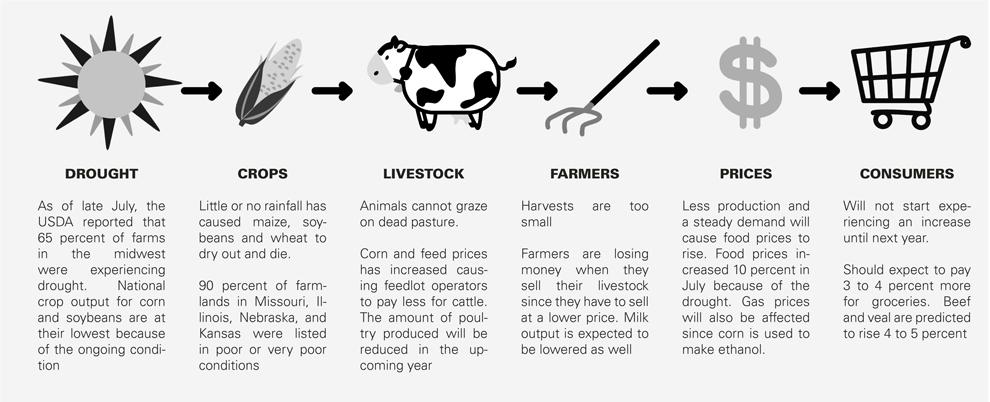 Prices in Southern California have risen nearly two and a half percent in the last year in part because of the drought, causing food prices to fluctuate.
Prices in Southern California have risen nearly two and a half percent in the last year in part because of the drought, causing food prices to fluctuate.
The drought has hit farming and food production hard. The Economic Research Service of the U.S. Department of Agriculture, or USDA, reports that more than 60 percent of American farms and livestock are in drought-affected areas.
Maize (corn), wheat, and soybean plants have been greatly affected by the drought. The World Bank claimed the price of wheat and maize rose 25 percent and soybeans rose by 17 percent worldwide. As a result of the drought, worldwide food prices jumped 10 percent in July.
The International Food Policy Research Institute, or IFPRI, reports nearly half of maize, soybeans and livestock are produced in areas of severe drought. IFPRI also claims the national crop yield estimates for maize and soybeans are the lowest they have been in years due to the ongoing drought conditions.
“Drought simply means dryness due to lack of precipitation,” said Dr. Helen Cox, director of the Institute for Sustainability and professor of geography at CSUN. “Extended time without rain is a drought, although the time without rain should be relative to the norm as it depends on the climate region.”
According to the National Weather Service, four states – Missouri, Illinois, Nebraska, and Kansas – reported more than 90 percent of their farmlands were in poor or very poor condition. The average farm in these areas produces soybeans, maize and wheat.
“Plants have a tolerance to drought that varies from species to species,” said Dr. Paula Schiffman, professor of biology at CSUN. “When a species reaches its tolerance limit, it’ll die out, barring exceptions in unique genetics of individual plants. As a result, the whole range of the plant changes.”
Prices for maize and soybean have reached record highs, according to IFPRI. Despite the record prices, the USDA estimates that the commodity price accounts for less than 15 percent of the food cost. Because the majority of the cost comes from processing, packaging and transport, consumers are not as affected as countries that import crops directly.
Livestock has also been affected since animals cannot graze on pasture and the cost of corn and other feed has gone up, according to the USDA. The increased feed cost has caused feedlot operators to pay less for cattle and reduce poultry output from now into the upcoming year.
Maize and soybeans are of particular international concern because the United States is the leading producer and exporter of maize and soybeans. Maize has uses ranging from ethanol oil to food consumption. Soybeans are used for infant formula, milk and oils.
Other producers of the crops, like Argentina, were experiencing drought earlier this year and lowered the nation’s soybean output to a three-year low, according to IFPRI.
The USDA has given drought disaster designations to 13 Midwestern states from as far north as Wisconsin and South Dakota to as far south as Texas and Louisiana. The designations help pave the way for federal financial assistance to farmers, which the Obama administration approved last month. Some of this assistance includes grazing on some federal lands, government loans, and the federal government purchasing large quantities of meat from producers.
Drought is not just about hot weather and lack of rain.
“In Southern California we are in the Mediterranean climate zone in which very little rainfall normally falls between May and October. Thus it is not a drought when our summer is dry,” Dr. Cox explained. “In other parts of the country however, like the Midwest, summer rain is the norm so weeks without rain can lead to extreme dryness. Dryness is also exacerbated by extreme heat, so a hot summer, like this one, will lead to drought because evaporation occurs more readily.”
The National Weather Service predicts that while drought conditions will not worsen due to the oncoming autumn seasonal change of temperature, conditions will not necessarily improve.
Dr. Cox argues for a connection between the ongoing drought and climate change.
“It is generally accepted among scientists that the frequency of occurrence of extreme weather events is likely to increase with global warming,” she said. “We can expect that extreme high temperatures, droughts, and hurricanes will become more severe as the planet warms.”





